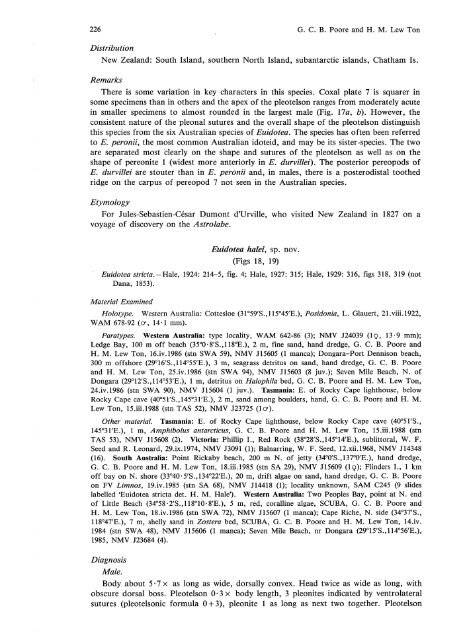Idoteidae of Australia and New Zealand (Crustacea: Isopoda: Valvif ...
Idoteidae of Australia and New Zealand (Crustacea: Isopoda: Valvif ...
Idoteidae of Australia and New Zealand (Crustacea: Isopoda: Valvif ...
Create successful ePaper yourself
Turn your PDF publications into a flip-book with our unique Google optimized e-Paper software.
226 G. C. B. Poore <strong>and</strong> H. M. Lew Ton<br />
Distribution<br />
<strong>New</strong> Zeal<strong>and</strong>: South Isl<strong>and</strong>, southern North Isl<strong>and</strong>, subantarctic isl<strong>and</strong>s, Chatham Is.<br />
Remarks<br />
There is some variation in key characters in this species. Coxal plate 7 is squarer in<br />
some specimens than in others <strong>and</strong> the apex <strong>of</strong> the pleotelson ranges from moderately acute<br />
in smaller specimens to almost rounded in the largest male (Fig. 17a, b). However, the<br />
consistent nature <strong>of</strong> the pleonal sutures <strong>and</strong> the overall shape <strong>of</strong> the pleotelson distinguish<br />
this species from the six <strong>Australia</strong>n species <strong>of</strong> Euidotea. The species has <strong>of</strong>ten been referred<br />
to E. peronii, the most common <strong>Australia</strong>n idoteid, <strong>and</strong> may be its sister-species. The two<br />
are separated most clearly on the shape <strong>and</strong> sutures <strong>of</strong> the pleotelson as well as on the<br />
shape <strong>of</strong> pereonite 1 (widest more anteriorly in E. durvillei). The posterior pereopods <strong>of</strong><br />
E. durvillei are stouter than in E. peronii <strong>and</strong>, in males, there is a posterodistal toothed<br />
ridge on the carpus <strong>of</strong> pereopod 7 not seen in the <strong>Australia</strong>n species.<br />
Etymology<br />
For Jules-Sebastien-Cesar Dumont d'Urville, who visited <strong>New</strong> Zeal<strong>and</strong> in 1827 on a<br />
voyage <strong>of</strong> discovery on the Astrolabe.<br />
Euidotea halei, sp. nov.<br />
(Figs 18, 19)<br />
Euidotea stricta.-Hale, 1924: 214-5, fig. 4; Hale, 1927: 315; Hale, 1929: 316, figs 318, 319 (not<br />
Dana, 1853).<br />
Material Examined<br />
Holotype. Western <strong>Australia</strong>: Cottesloe (31°59'S.,115°45'E.), Posidonia, L. Glauert, 21.viii.1922,<br />
WAM 678-92 (o% 14-1 mm).<br />
Paratypes. Western <strong>Australia</strong>: type locality, WAM 642-86 (3); NMV J24039 (lo, 13-9 mm);<br />
Ledge Bay, 100 m <strong>of</strong>f beach (35°0-8'S.,118°E.), 2 m, fine s<strong>and</strong>, h<strong>and</strong> dredge, G. C. B. Poore <strong>and</strong><br />
H. M. Lew Ton, 16.iv.1986 (stn SWA 59), NMV J15605 (1 manca); Dongara-Port Dennison beach,<br />
300 m <strong>of</strong>fshore (29°16'S.,114°55'E.), 3 m, seagrass detritus on s<strong>and</strong>, h<strong>and</strong> dredge, G. C. B. Poore<br />
<strong>and</strong> H. M. Lew Ton, 25.iv.1986 (stn SWA 94), NMV J15603 (8 juv.); Seven Mile Beach, N. <strong>of</strong><br />
Dongara (29°12'S.,114°53'E.), 1 m, detritus on Halophila bed, G. C. B. Poore <strong>and</strong> H. M. Lew Ton,<br />
24.iv.1986 (stn SWA 90), NMV J15604 (1 juv.). Tasmania: E. <strong>of</strong> Rocky Cape lighthouse, below<br />
Rocky Cape cave (40°5rS.,145 o 31'E.), 2 m, s<strong>and</strong> among boulders, h<strong>and</strong>, G. C. B. Poore <strong>and</strong> H. M.<br />
Lew Ton, 15.iii.1988 (stn TAS 52), NMV J23725 (lo-).<br />
Other material. Tasmania: E. <strong>of</strong> Rocky Cape lighthouse, below Rocky Cape cave (40°51'S.,<br />
145°31'E.), 1 m, Amphibolus antarcticus, G. C. B. Poore <strong>and</strong> H. M. Lew Ton, 15.iii.1988 (stn<br />
TAS 53), NMV J15608 (2). Victoria: Phillip I., Red Rock (38°28'S.,145°14'E.), sublittoral, W. F.<br />
Seed <strong>and</strong> R. Leonard, 29.ix.1974, NMV J3091 (1); Balnarring, W. F. Seed, 12.xii.1968, NMV J14348<br />
(16). South <strong>Australia</strong>: Point Rickaby beach, 200 m N. <strong>of</strong> jetty (34°0'S.,137°0'E.), h<strong>and</strong> dredge,<br />
G. C. B. Poore <strong>and</strong> H. M. Lew Ton, 18.iii.1985 (stn SA 29), NMV J15609 (I9); Flinders I., 1 km<br />
<strong>of</strong>f bay on N. shore (33°40-5'S.,134°22'E.), 20 m, drift algae on s<strong>and</strong>, h<strong>and</strong> dredge, G. C. B. Poore<br />
on FV Limnos, 19.iv.1985 (stn SA 68), NMV J14418 (1); locality unknown, SAM C245 (9 slides<br />
labelled 'Euidotea stricta det. H. M. Hale'). Western <strong>Australia</strong>: Two Peoples Bay, point at N. end<br />
<strong>of</strong> Little Beach (34 o 58-2'S.,118°10-8'E.), 5 m, red, coralline algae, SCUBA, G. C. B. Poore <strong>and</strong><br />
H. M. Lew Ton, 18.iv.1986 (stn SWA 72), NMV J15607 (1 manca); Cape Riche, N. side (34°37'S.,<br />
118°47'E.), 7 m, shelly s<strong>and</strong> in Zostera bed, SCUBA, G. C. B. Poore <strong>and</strong> H. M. Lew Ton, 14.iv.<br />
1984 (stn SWA 48), NMV J15606 (1 manca); Seven Mile Beach, nr Dongara (29°15'S.,114 0 56'E.),<br />
1985, NMV J23684 (4).<br />
Diagnosis<br />
Male.<br />
Body about 5-7x as long as wide, dorsally convex. Head twice as wide as long, with<br />
obscure dorsal boss. Pleotelson 0-3 x body length, 3 pleonites indicated by ventrolateral<br />
sutures (pleotelsonic formula 0 + 3), pleonite 1 as long as next two together. Pleotelson
















